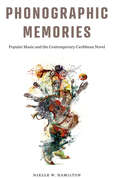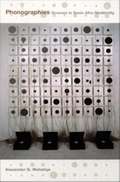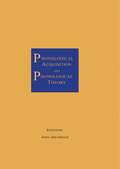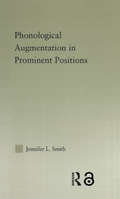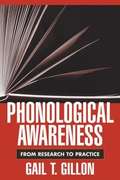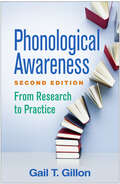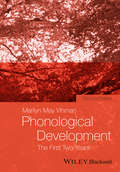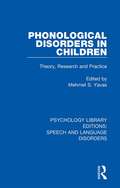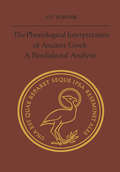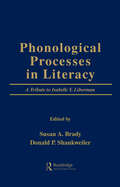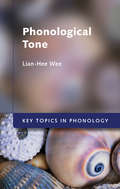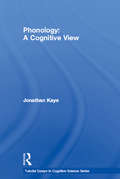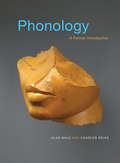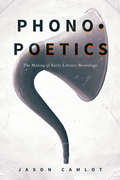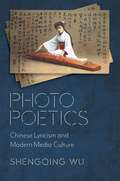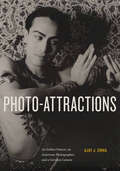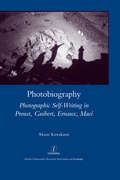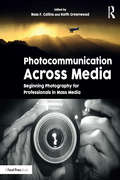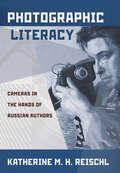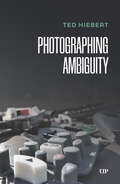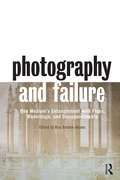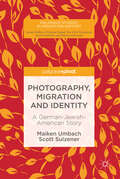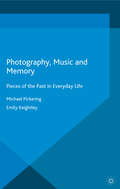- Table View
- List View
Phonographic Memories: Popular Music and the Contemporary Caribbean Novel (Critical Caribbean Studies)
by Njelle W. HamiltonPhonographic Memories is the first book to perform a sustained analysis of the narrative and thematic influence of Caribbean popular music on the Caribbean novel. Tracing a region-wide attention to the deep connections between music and memory in the work of Lawrence Scott, Oscar Hijuelos, Colin Channer, Daniel Maximin, and Ramabai Espinet, Njelle Hamilton tunes in to each novel’s soundtrack while considering the broader listening cultures that sustain collective memory and situate Caribbean subjects in specific localities. These “musical fictions” depict Caribbean people turning to calypso, bolero, reggae, gwoka, and dub to record, retrieve, and replay personal and cultural memories. Offering a fresh perspective on musical nationalism and nostalgic memory in the era of globalization, Phonographic Memories affirms the continued importance of Caribbean music in providing contemporary novelists ethical narrative models for sounding marginalized memories and voices. Njelle W. Hamilton's Spotify playlist to accompany Phonographic Memories: https://spoti.fi/2tCQRm8
Phonographies: Grooves in Sonic Afro-Modernity
by Alexander G. WeheliyePhonographies explores the numerous links and relays between twentieth-century black cultural production and sound technologies from the phonograph to the Walkman. Highlighting how black authors, filmmakers, and musicians have actively engaged with recorded sound in their work, Alexander G. Weheliye contends that the interplay between sound technologies and black music and speech enabled the emergence of modern black culture, of what he terms "sonic Afro-modernity. " He shows that by separating music and speech from their human sources, sound-recording technologies beginning with the phonograph generated new modes of thinking, being, and becoming. Black artists used these new possibilities to revamp key notions of modernity--among these, ideas of subjectivity, temporality, and community. Phonographies is a powerful argument that sound technologies are integral to black culture, which is, in turn, fundamental to Western modernity. Weheliye surveys literature, film, and music to focus on engagements with recorded sound. He offers substantial new readings of canonical texts by W. E. B. Du Bois and Ralph Ellison, establishing dialogues between these writers and popular music and film ranging from Louis Armstrong's voice to DJ mixing techniques to Darnell Martin's 1994 movie I Like It Like That. Looking at how questions of diasporic belonging are articulated in contemporary black musical practices, Weheliye analyzes three contemporary Afro-diasporic musical acts: the Haitian and African American rap group the Fugees, the Afro- and Italian-German rap collective Advanced Chemistry, and black British artist Tricky and his partner Martina. Phonographies imagines the African diaspora as a virtual sounding space, one that is marked, in the twentieth century and twenty-first, by the circulation of culture via technological reproductions--records and tapes, dubbing and mixing, and more.
Phonological Acquisition and Phonological Theory
by John ArchibaldMuch of the work currently conducted within the framework of Universal Grammar and language learnability focuses on the acquisition of syntax. However, the learnability issues are just as applicable to the domain of phonology. This volume is the first to gather research that assumes a sophisticated phonological framework and considers the implications of this framework for language acquisition -- both first and second. As such, this book truly deals with phonological acquisition rather than phonetic acquisition.
Phonological Augmentation in Prominent Positions (Outstanding Dissertations in Linguistics)
by Jennifer L. SmithPhonologically prominent or "strong" positions are well known for their ability to resist positional neutralization processes such as vowel reduction or place assimilation. However, there are also cases of neutralization that affect only strong positions, as when stressed syllables must be heavy, default stress is inserted into roots, or word-initial onsets must be low in sonority. In this book, Jennifer Smith shows that phonological processes specific to strong positions are distinct from those involved in classic positional neutralization effects because they always serve to augment the strong position with a perceptually salient characteristic. Formally, positional augmentation effects are modeled by means of markedness constraints relativized to strong positions. Because positional augmentation constraints are subject to certain substantive restrictions, as seen in their connection to perceptual salience, this study has implications for the relationship between functional grounding and phonological theory.
Phonological Awareness
by Gail T. GillonThis unique resource provides a comprehensive review of current knowledge about phonological awareness, together with practical guidance for helping preschoolers to adolescents acquire needed skills. Up-to-date findings are synthesized on the development of phonological awareness; its role in literacy learning; and how it can be enhanced in students at risk for reading difficulties and those with reading disorders or speech or language impairments. Of particular value to general and special educators and speech language professionals, the book's clear recommendations for assessment and intervention show how to translate the research into day-to-day teaching and clinical practice.
Phonological Awareness, Second Edition: From Research to Practice
by Gail T. GillonTranslating cutting-edge research into practical recommendations for assessment and instruction, this book has helped thousands of readers understand the key role of phonological awareness in the development of reading, writing, and spelling. It clearly shows how children's knowledge about the sound structure of spoken language contributes to literacy acquisition. Evidence-based strategies are described for enhancing all learners' phonological awareness and effectively supporting those who are struggling (ages 3–17). The book discusses ways to tailor instruction and intervention for a broad range of students, including English language learners (ELLs) and those with reading or language disorders. New to This Edition: *Incorporates over a decade of important advances in research, assessment, and instruction. *Chapter on ELLs, plus additional insights on ELLs woven throughout the book, including new case studies. *Chapter on spelling development. *Significantly revised coverage of children with complex communication needs.
Phonological Development
by Marilyn May VihmanDrawing on major research developments in the field, Vihman has updated and extensively revised the 1996 edition of her classic text to provide a thorough and stimulating overview of current studies of child production and perception and early word learning.Offers a full survey of the thinking on how babies develop phonological knowledgeProvides a much needed update on the field - one in which this book remains unique, and in which there have also been dramatic developments since the publication of the first editionSurveys what has been learned about phonological development and raises questions for further studyThe only book that includes balanced treatment of research in perception and production and attempts a synthesis of these fields, which have generally developed in isolation from one anotherIncludes a new chapter providing an overview of communicative and attentional development, as well as perceptual and vocal development, in the first 18 months, with additional focus on both implicit and explicit learning mechanisms
Phonological Disorders in Children: Theory, Research and Practice (Psychology Library Editions: Speech and Language Disorders)
by Mehmet S. YavasOriginally published in 1991, the recent developments in the study of phonological disorders in children had led to a fruitful interaction between speech pathology and phonology. It is one aspect of the application of linguistic theory to the study of speech and language disorders which had opened up a new field, clinical linguistics. This book brings together the concerns of the linguist and the speech pathologist; the essays chosen share the quality of not discussing theory or therapy without addressing the implications one has for the other. By concentrating on recent work the editor hoped to stimulate further discussion in this important and fast growing area of research.
Phonological Interpretation of Ancient Greek, The: A Pandialectal Analysis
by Vit BubenikThis volume treats systematically the variation found in the successive stages of the development of all ancient Greek dialects. It combines synchronic approach, in which generative rules expound phonological divergencies between the systems of different dialects, with a diachronic statement of unproductive and mostly pan-Hellenic shifts.Professor Bubeník presents a phonetic description and structural phonemic analysis of the best-known variant--Classical Attic of the 5th century B.C.--and displays and contrasts the vocalic and consonantal inventories of all the other dialects classified according to their major groups. Derivational histories of individual dialects are examined in their juxtaposition, to ascertain which rules are shared by various dialects and which are dialect-specific. The pandialectal framework enables Bubeník to capture various relationships among genetically related dialects which are missed in atomistic and static treatments, and to show more convincingly the extent of their similarity and their systemic cohesion.This volume makes a significant contribution to both classical scholarship and current theory of language change by offering new analyses of a variety of phonological and morphophonemic problems presented by a dead language and its dialects.
Phonological Processes in Literacy: A Tribute to Isabelle Y. Liberman
by Susan A. Brady Donald P. ShankweilerThis impressive volume contains the edited proceedings of a symposium held in honor of Isabelle Y. Liberman, whose teaching and writings laid the foundation for contemporary views of reading disability. Her work has influenced ways of thinking about the nature of the problem and ways of working with children and adults who experience unusual difficulty in learning to read. The symposium covered four themes that were central to Dr. Liberman's research on reading acquisition and disability: the development of phonological awareness, the relationship between phonological awareness and success in learning to read and write, the investigation of other phonological processes associated with reading and writing performance, and the implications of current research on these matters for reading instruction. The text includes a paper on each topic, followed by commentaries which introduce additional research findings and theoretical considerations -- all by leading researchers in the field.
Phonological Tone (Key Topics in Phonology)
by Lian-Hee WeeFrom the physiology and acoustics to their patterning across human languages, tone is one of the fundamental constructs in human languages that is also among the hardest to apprehend. Drawing upon a large number of languages around the world, this volume explores the concept of tone starting from its physical properties of articulation and acoustics to its manifestation in phonology. Designed as a comprehensive study accessible to the novice and useful for the expert, each chapter covers a particular aspect of tone in increasing depth and complexity, weaving together key concepts and theories that provide complementing or competing accounts of tone's phonological intricacies. In the process, one uncovers the underlying laws and principles that inform today's understanding of the subject to form a more synthesized view that also allows us to explore the relation of tone to other important areas of humanity such as literature, history, music and cognition.
Phonology as Human Behavior: Theoretical Implications and Clinical Applications
by Yishai TobinPhonology as Human Behavior brings work in human cognition, behavior, and communication to bear on the study of phonology--the theory of sound systems in language. Yishai Tobin extends the ideas of William Diver--an influential linguist whose investigations into phonology reflect the principle that language represents a constant search for maximum communication with minimal effort--as a part of a new theory of phonology as human behavior. Showing the far-reaching psycho- and sociolinguistic utility of this theory, Tobin demonstrates its applicability to the teaching of phonetics, text analysis, and the theory of language acquisition.Tobin describes the methodological connection between phonological theory and phonetics by way of a comprehensive and insightful survey of phonology's controversial role in twentieth-century linguistics. He reviews the work of Saussure, Jakobson, Troubetzkoy, Martinet, Zipf, and Diver, among others, and discusses issues in distributional phonology through analyses of English, Italian, Latin, Hebrew, and Yiddish. Using his theory to explain various functional and pathological speech disorders, Tobin examines a wide range of deviant speech processes in aphasia, the speech of the hearing-impaired, and other syndromes of organic origin. Phonology as Human Behavior provides a unique set of principles connecting the phylogeny, ontogeny, and pathology of sound systems in human language.
Phonology in English Language Teaching: An International Approach (Applied Linguistics and Language Study)
by Martha C. PenningtonPhonology in English Language Teaching is an introductory text, specifically directed at the needs of language teachers internationally. Combining an overview of English phonology with structured practical guidance, this text shows how phonology can be applied in the classroom.An introductory chapter provides the philosophical framework, followed by separate chapters on the phonology of consonants, vowels and prosody. As well as presenting core material on English phonology, the book explores the relationship of orthography to the English sound system from a historical and a present-day perspective. The final chapter focuses on lesson design and provides practical advice to teachers on diagnosing and responding to students' pronunciation difficulties.As central themes, the book examines English seen from the perspective of international usage and considers the relationship of phonology to communication and the broader language curriculum. Consistent with its practical and communicative orientation each chapter concludes with pedagogical exercises and ideas for classroom and community research projects.
Phonology: A Cognitive View (Tutorial Essays in Cognitive Science Series)
by Jonathan KayeDesigned to acquaint the reader with the field of phonology -- the study of the systems of linguistically significant sounds -- this book begins with a brief introduction to linguistics and a discussion of phonology's place within that field. It then goes on to cover a variety of topics including the nature of phonological units, phonological rules, which types of phenomena interest phonologists, and the evolution of phonological theory. Suitable for many applications, this volume assumes no previous knowledge of linguistics. An excellent text for use in first or second year phonology courses, it will also be of value to those involved in cognitive science, neuroscience, artificial intelligence and computer science.
Phonology: A Formal Introduction (The\mit Press Ser.)
by Alan Bale Charles ReissAn introduction to generative phonology using tools of basic set theory, logic, and combinatorics.This textbook introduces phonological theory as a branch of cognitive science for students with minimal background in linguistics. The authors use basic math and logic, including set theory, some rules of inference, and basic combinatorics, to explain phonology, and use phonology to teach the math and logic. The text is unique in its focus on logical analysis, its use of toy data, and its provision of some interpretation rules for its phonological rule syntax.The book's eight parts cover preliminary and background material; the motivation for phonological rules; the development of a formal model for phonological rules; the basic logic of neutralization rules; the traditional notions of allophony and complementary distribution; the logic of rule interaction, presented in terms of function composition; a survey of such issues as length, tone, syllabification, and metathesis; and features and feature logic, with a justification of decomposing segments into features and treating segments as sets of (valued) features. End-of-chapter exercises help students apply the concepts presented. Much of the discussion and many of the exercises rely on toy data, but more “real” data is included toward the end of the book. Exercises available online can be used as homework or in-class quizzes.
Phonopoetics: The Making of Early Literary Recordings
by Jason CamlotPhonopoetics tells the neglected story of early "talking records" and their significance for literature, from the 1877 invention of the phonograph to some of the first recorded performances of modernist works. The book challenges assumptions of much contemporary criticism by taking the recorded, oral performance as its primary object of analysis and by exploring the historically specific convergences between audio recording technologies, media formats, generic forms, and the institutions and practices surrounding the literary. Opening with an argument that the earliest spoken recordings were a mediated extension of Victorian reading and elocutionary culture, Jason Camlot explains the literary significance of these pre-tape era voice artifacts by analyzing early promotional fantasies about the phonograph as a new kind of speaker and detailing initiatives to deploy it as a pedagogical tool to heighten literary experience. Through historically-grounded interpretations of Dickens impersonators to recitations of Tennyson to T.S. Eliot's experimental readings of "The Waste Land" and of a great variety of voices and media in between, this first critical history of the earliest literary sound recordings offers an unusual perspective on the transition from the Victorian to modern periods and sheds new light on our own digitally mediated relationship to the past.
Photo Poetics: Chinese Lyricism and Modern Media Culture (Global Chinese Culture)
by Shengqing WuChinese poetry has a long history of interaction with the visual arts. Classical aesthetic thought held that painting, calligraphy, and poetry were cross-fertilizing and mutually enriching. What happened when the Chinese poetic tradition encountered photography, a transformative technology and presumably realistic medium that reshaped seeing and representing the world?Shengqing Wu explores how the new medium of photography was transformed by Chinese aesthetic culture. She details the complex negotiations between poetry and photography in the late Qing and early Republican eras, examining the ways traditional textual forms collaborated with the new visual culture. Drawing on extensive archival research into illustrated magazines, poetry collections, and vintage photographs, Photo Poetics analyzes a wide range of practices and genres, including self-representation in portrait photography; gifts of inscribed photographs; mass-media circulation of images of beautiful women; and photography of ghosts, immortals, and imagined landscapes. Wu argues that the Chinese lyrical tradition provided rich resources for artistic creativity, self-expression, and embodied experience in the face of an increasingly technological and image-oriented society. An interdisciplinary study spanning literary studies, visual culture, and media history, Photo Poetics is an original account of media culture in early twentieth-century China and the formation of Chinese literary and visual modernities.
Photo-Attractions: An Indian Dancer, an American Photographer, and a German Camera
by Ajay SinhaIn Spring 1938, an Indian dancer named Ram Gopal and an American writer-photographer named Carl Van Vechten came together for a photoshoot in New York City. Ram Gopal was a pioneer of classical Indian dance and Van Vechten was reputed as a prominent white patron of the African-American movement called the Harlem Renaissance. Photo-Attractions describes the interpersonal desires and expectations of the two men that took shape when the dancer took pose in exotic costumes in front of Van Vechten’s Leica camera. The spectacular images provide a rare and compelling record of an underrepresented history of transcultural exchanges during the interwar years of early-20th century, made briefly visible through photography. Art historian Ajay Sinha uses these hitherto unpublished photographs and archival research to raise provocative and important questions about photographic technology, colonial histories, race, sexuality and transcultural desires. Challenging the assumption that Gopal was merely objectified by Van Vechten’s Orientalist gaze, he explores the ways in which the Indian dancer co-authored the photos. In Sinha’s reading, Van Vechten’s New York studio becomes a promiscuous contact zone between world cultures, where a “photo-erotic” triangle is formed between the American photographer, Indian dancer, and German camera. A groundbreaking study of global modernity, Photo-Attractions brings scholarship on American photography, literature, race and sexual economies into conversation with work on South Asian visual culture, dance, and gender. In these remarkable historical documents, it locates the pleasure taken in cultural difference that still resonates today.
Photobiography: Photographic Self-writing in Proust, Guibert, Ernaux, Mace
by Akane Kawakami"Why do photographs interest writers, especially autobiographical writers? Ever since their invention, photographs have featured - as metaphors, as absent inspirations, and latterly as actual objects - in written texts. In autobiographical texts, their presence has raised particularly acute questions about the rivalry between these two media, their relationship to the 'real', and the nature of the constructed self. In this timely study, based on the most recent developments in the fields of photography theory, self-writing and photo-biography, Akane Kawakami offers an intriguing narrative which runs from texts containing metaphorical photographs through ekphrastic works to phototexts. Her choice of Marcel Proust, Herve Guibert, Annie Ernaux and Gerard Mace provides unusual readings of works seldom considered in this context, and teases out surprising similarities between unexpected conjunctions. Akane Kawakami is a Senior Lecturer in French and francophone literature at Birkbeck University of London."
Photocommunication Across Media: Beginning Photography for Professionals in Mass Media
by Ross Collins Keith GreenwoodPhotocommunication Across Media is a must-have for aspiring mass media professionals who are striving to compete in the new landscape of convergence journalism and media. You will learn principles of photography both still and video and how to incorporate them into your storytelling. That’s no longer a specialty skill—in today’s world of media, it’s a necessity. Editors Ross Collins and Keith Greenwood collaborate with highly accomplished photographers to make the concepts and techniques of today’s mass media photography accessible to all readers. Photocommunication Across Media speaks directly to journalists, advertisers and professional communicators who want to round out their toolkit without sifting through dense texts meant specifically for photographers and photojournalists. This guide, edited by experts who teach these concepts to the next generation of media professionals, is everything you need to know—and nothing you don’t—to take the next step for your career in communication.
Photographic Literacy: Cameras in the Hands of Russian Authors
by Katherine M. ReischlPhotography, introduced to Russia in 1839, was nothing short of a sensation. Its rapid proliferation challenged the other arts, including painting and literature, as well as the very integrity of the self. If Leo Tolstoy and Fyodor Dostoevsky greeted the camera with skepticism in the nineteenth century, numerous twentieth-century authors welcomed it with a warm embrace. As Katherine M. H. Reischl shows in Photographic Literacy, authors as varied as Leonid Andreev, Ilya Ehrenburg, and Alexander Solzhenitsyn picked up the camera and reshaped not only their writing practices but also the sphere of literacy itself.For these authors, a single photograph or a photograph as illustration is never an endpoint; their authorial practices continually transform and animate the frozen moment. But just as authors used images to shape the reception of their work and selves, Russian photographers—including Sergei Prokudin-Gorsky and Alexander Rodchenko—used text to shape the reception of their visual work. From the diary to print, the literary word imbues that photographic moment with a personal life story, and frames and reframes it in the writing of history. In this primer on photographic literacy, Reischl argues for the central place that photography has played in the formation of the Russian literary imagination over the course of roughly seventy years. From image to text and back again, she traces the visual consciousness of modern Russian literature as captured through the lens of the Russian author-photographer.
Photographing Ambiguity (Digital Futures)
by Ted HiebertPhotographing Ambiguity examines photography as a metaphor for technological culture, arguing that a relational exploration of the medium can shed light on the dominant ideological tendencies of our time. The book advocates for photographic practices that emphasize ambiguity, suggesting that this approach fosters more conscientious, ecological, and creative relationships within the technological ecosystem of contemporary life. Ted Hiebert critiques the notion that images should primarily serve to verify or document the external world. He contends that these quantifiable perspectives, while rooted in historical trends towards technology and data, have become so pervasive that they represent a dominant ideological bias in the twenty-first century. In response to this data-driven consciousness, the book presents a series of exercises designed to cultivate an embodied experience with digital living – not in opposition to the flood of images but within it. Ultimately, Photographing Ambiguity encourages readers to understand photographs not as benchmarks of reality but as ambiguous constructions of our present and future imaginaries.
Photography and Failure: One Medium's Entanglement with Flops, Underdogs and Disappointments
by Kris Belden-AdamsThroughout photography’s history, failure has played an essential, recurring part in the development and perceived value of this medium. Exploring a range of failures – individual and institutional, technological and historiographical – Photography and Failure asks what it means to fail and considers how this narrative of failure has shaped our understanding of photography. From the trial-and-error beginnings of photochemistry to poor business decisions influenced by fickle public opinion and taste, the founders and early practitioners of photography frequently faced bankruptcy and ignominy. Alongside these individual ‘failures’, this collection of essays examines the role of museums in rediscovering, preserving and presenting photographs within institutions, as well as technological limitations, such as the problematic panoramic lens or the digital, archival failures of Snapchat. Moving beyond the physical photograph and these processes, the book also investigates the limitations of photographs themselves, as purveyors of truth, time, space, documentary realism and social change, whether these failures are used to effect or not. Finally, the book probes the historiographical failures affecting the discipline, drawing on key debates, such as the perceived over-emphasis on European and American photography, and the place of photography theory in contemporary art practice. Blurring the boundaries between traditional binaries of art and non-art photography, amateur and professional practice, and individual and corporate perspectives, Photography and Failure presents a new approach to understanding and evaluating photographic history.
Photography, Migration and Identity: A German-Jewish-American Story (Palgrave Studies in Migration History)
by Maiken Umbach Scott SulzenerBetween the 1933 Nazi seizure of power and their 1941 prohibition on all Jewish emigration, around 90,000 German Jews moved to the United States. Using the texts and images from a personal archive, this Palgrave Pivot explores how these refugees made sense of that experience. For many German Jews, theirs was not just a story of flight and exile; it was also one chapter in a longer history of global movement, experienced less as an estrangement from Germanness, than a reiteration of the mobility central to it. Private photography allowed these families to position themselves in a context of fluctuating notions of Germaness, and resist the prescribed disentanglement of their Jewish and German identities. In opening a unique window onto refugees’ own sense of self as they moved across different geographical, political, and national environments, this book will appeal to readers interested in Jewish life and migration, visual culture, and the histories of National Socialism and the Holocaust.
Photography, Music and Memory: Pieces of the Past in Everyday Life (Palgrave Macmillan Memory Studies)
by Michael Pickering Emily KeightleyThis book explores how photography and recorded music act as vehicles or catalysts in processes of remembering, and how they are regarded, treated, valued and drawn upon as resources connecting past and present in everyday life. It does so via two key concepts: vernacular memory and the mnemonic imagination.
